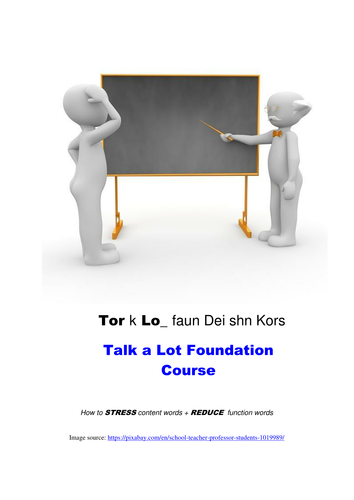


The focus of this course is pronunciation – how we speak. The message of the entire course can be summed up in two words: stress and reduce – learners can improve their pronunciation by stressing the content words in a sentence and reducing the function words – then connecting the syllables together. The aim of the course is to teach learners how to do this. Learners will also develop their listening skills as they discover the techniques that English native speakers routinely use when speaking quickly.
This is not a book to be picked up and read from beginning to end, but rather a collection of practical materials that need to be studied within the context of a course – guided by a teacher. This is not really a self-study book, although I’m sure learners could learn a lot from reading it on their own, and listening to the audio files (see below). The course is made up of four lessons of theory – Introduction and Basic Principles; Spelling and Sounds; Stress; and Connected Speech. There is also a fifth lesson with practical exercises, which can be repeated as often as you like – or have time for. This book contains the course material for each lesson, which may be given to learners on the course, and which the teacher can use to plan and facilitate the lessons.
The materials in this course are fairly flexible. Each lesson has an outline of the main points, which are described in more detail in boxes, and then followed by examples and practical activities. You don’t have to follow this course as it is written word by word, doing every activity – although you could. You may decide to use the text as an outline, adding extra activities and examples that are more relevant for your learners, and taking away things that they don’t need. The timing of each lesson can vary – it will depend on the level of your learners, and how much time there is available. I would recommend a classroom session of at least 90 minutes for covering one of the theory lessons.
Get this resource as part of a bundle and save up to 96%
A bundle is a package of resources grouped together to teach a particular topic, or a series of lessons, in one place.
ESL Super Bundle
Here are lots of different fun teaching resources for students who are learning to speak English as a second language, or for students who want to revise and improve their understanding of English. This is perfect for both an home or school setting.
Learning English The Fun Way! - Bundle
Are you learning English as a second language (ESL)? Are you looking for a fun way to learn English as a second language? I have developed a way to learn different languages based on my experience as an ESL teacher. This pack has 57 different settings for students to talk about in English as a second language. The worksheets themselves are in English and the students do need to translate the places and objects they see into English as a second language. At the end of the session, the students can play a fun game of word bingo to show they have mastered that day's vocabulary. Try it, it is a lot of fun for everyone!
Something went wrong, please try again later.
Report this resourceto let us know if it violates our terms and conditions.
Our customer service team will review your report and will be in touch.